University of Tokyo
Coordinates: 35°42′48″N 139°45′44″E / 35.71333°N 139.76222°E
| 東京大学 | |
 | |
| Latin: Universitas Tociensis | |
Former names |
Imperial University (1886–1897) Tokyo Imperial University (1897–1947) |
|---|---|
| Type | Public (National) |
| Established | 1877 |
Academic affiliations |
IARU APRU AEARU AGS BESETOHA |
| President |
Makoto Gonokami (五神真) |
Academic staff |
2,429 full-time 175 part-time[1] |
Administrative staff | 5,779 |
| Students | 28,697[2] |
| Undergraduates | 14,274 |
| Postgraduates | 13,732 |
| 6,022 | |
Other students | 747 research students |
| Location | Bunkyō, Tokyo, Japan |
| Campus | Urban |
| Colors | Light Blue |
| Athletics | 46 varsity teams |
| Website | u-tokyo.ac.jp |
 | |
The University of Tokyo (東京大学 Tōkyō daigaku), abbreviated as Todai (東大 Tōdai)[3] or UTokyo,[4] is a public research university located in Bunkyo, Tokyo, often cited as the most prestigious university in Japan.
The university has 10 faculties with a total of around 30,000 students, 2,100 of whom are foreign. Its five campuses are in Hongō, Komaba, Kashiwa, Shirokane and Nakano. It is the first of Japan's National Seven Universities.[5][6]
History
The university was chartered by the Meiji government in 1877 under its current name by amalgamating older government schools for medicine and Western learning. It was renamed "the Imperial University (帝國大學 Teikoku daigaku)" in 1886, and then Tokyo Imperial University (東京帝國大學 Tōkyō teikoku daigaku) in 1897 when the Imperial University system was created. In September 1923, an earthquake and the following fires destroyed about 700,000 volumes of the Imperial University Library.[7] The books lost included the Hoshino Library (星野文庫 Hoshino bunko), a collection of about 10,000 books.[7][8] The books were the former possessions of Hoshino Hisashi before becoming part of the library of the university and were mainly about Chinese philosophy and history.
In 1947, after Japan's defeat in World War II, it re-assumed its original name. With the start of the new university system in 1949, Todai swallowed up the former First Higher School (today's Komaba campus) and the former Tokyo Higher School, which thenceforth assumed the duty of teaching first- and second-year undergraduates, while the faculties on Hongo main campus took care of third- and fourth-year students.
Although the university was founded during the Meiji period, it has earlier roots in the Astronomy Agency (天文方; 1684), Shoheizaka Study Office (昌平坂学問所; 1797), and the Western Books Translation Agency (蕃書和解御用; 1811).[9] These institutions were government offices established by the 徳川幕府 Tokugawa shogunate (1603–1867), and played an important role in the importation and translation of books from Europe.
Kikuchi Dairoku, an important figure in Japanese education, served as president of Tokyo Imperial University.
For the 1964 Summer Olympics, the university hosted the running portion of the modern pentathlon event.[10]
On 20 January 2012, Todai announced that it would shift the beginning of its academic year from April to September to align its calendar with the international standard. The shift would be phased in over five years.[11][12] But this unilateral announcement by the president was received badly and the university abandoned the plans.
According to the Japan Times, the university had 1,282 professors in February 2012. Of those, 58 were women.[11]
In the fall of 2012 and for the first time, the University of Tokyo started two undergraduate programs entirely taught in English and geared toward international students — Programs in English at Komaba (PEAK) — the International Program on Japan in East Asia and the International Program on Environmental Sciences.[13][14] In 2014, the School of Science at the University of Tokyo introduced an all-English undergraduate transfer program called Global Science Course (GSC).[15]
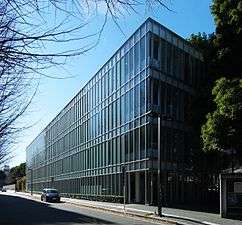 Tokyo University School of Law Building
Tokyo University School of Law Building Komaba Library
Komaba Library Main Building of Institute for Solid State Physics of the University of Tokyo
Main Building of Institute for Solid State Physics of the University of Tokyo Koishikawa Botanical Gardens
Koishikawa Botanical Gardens Komaba research campus
Komaba research campus
Organization
Faculties
- Law
- Medicine
- Engineering
- Letters
- Science
- Agriculture
- Economics
- Arts and Sciences
- Education
- Pharmaceutical Sciences
Graduate schools
- Humanities and Sociology
- Education
- Law and Politics
- Economics
- Arts and Sciences
- Science
- Engineering
- Agricultural and Life Sciences
- Medicine
- Pharmaceutical Sciences
- Mathematical Sciences
- Frontier Sciences
- Information Science and Technology
- Interdisciplinary Information Studies
- Public Policy
Research institutes
- Institute of Medical Science
- Earthquake Research Institute
- Institute of Oriental Culture
- Institute of Social Science
- Institute of Industrial Science
- Historiographical Institute
- Institute of Molecular and Cellular Biosciences
- Institute for Cosmic Ray Research
- Institute for Solid State Physics
- Atmosphere and Ocean Research Institute
- Research Center for Advanced Science and Technology
The University's School of Science and the Earthquake Research Institute are both represented on the national Coordinating Committee for Earthquake Prediction.[17]
Ranking
| University rankings | |
|---|---|
| Global | |
| ARWU[18] | 20 |
| Times[19] | 43 |
| QS[20] | 34 |
| Asia | |
| ARWU[21] | 1 |
| Times[22] | 7 |
| QS[23] | 13 |
- Academic Ranking of World Universities ranked the University of Tokyo 1st in Asia and 20th in the world in 2012.
- Times Higher Education World University Rankings ranked the University of Tokyo 27th in the world in 2013[24] and 1st in the Asia University ranking in 2013.[25] In 2015, Times Higher Education World University Rankings ranked the institution 23rd in the world.[26] It ranks 12th in the world according to the Times Higher Education World Reputation Rankings 2016.
- QS World University Rankings[27] in 2011 ranked the University of Tokyo 25th in the world (in 2010 Times Higher Education World University Rankings and QS World University Rankings parted ways to produce separate rankings). In the 2011 QS Asian University Rankings, which employs a different methodology, the University of Tokyo came 4th.[28] Currently, University of Tokyo holds ranks 9th & 11th respectively for Natural Sciences & Engineering, two of its traditionally strong disciplines.[29][30]
- Times Higher Education World Reputation Rankings ranked the University of Tokyo 12th in the world also 1st in Asia in 2016.
- Global University Ranking ranked the University of Tokyo 3rd in the world and 1st in Asia.[31]
- Human Resources & Labor Review, a human competitiveness index & analysis published in Chasecareer Network, ranked the university 21st internationally and 1st in Asia in 2010.[32]
- Mines ParisTech : Professional Ranking World Universities ranked the University of Tokyo 2nd in the world on the basis of the number of alumni listed among CEOs in the 500 largest worldwide companies.[33]
- Nature Publishing Index (2011) ranked the University of Tokyo 5th in the world in 2011.[34]
Campus
Hongo Campus
The main Hongo campus occupies the former estate of the Maeda family, Edo period feudal lords of Kaga Province. One of the university's best known landmarks, Akamon (the Red Gate), is a relic of this era. The symbol of the university is the ginkgo leaf, from the trees found throughout the area. The Hongo campus also hosts the University of Tokyo's annual May Festival.[35]
- Yasuda Auditorium
- Akamon (the Red Gate)
- Letters building
 Information Center
Information Center First Medical Building
First Medical Building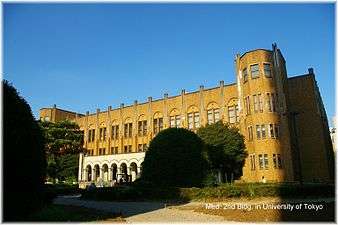 Second Medical Building
Second Medical Building Medical Experimental Research Bldg.
Medical Experimental Research Bldg. Medical Library
Medical Library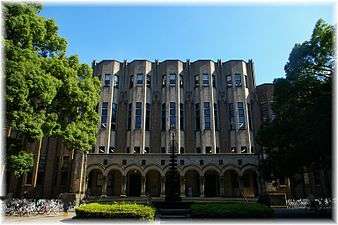 General Library
General Library The Experimental Tank
The Experimental Tank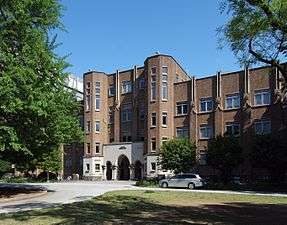 Faculty of Engineering
Faculty of Engineering
Sanshiro Pond
Sanshiro Pond (三四郎池 Sanshirō ike), university's Hongo campus, dates to 1615. After the fall of the Osaka Castle, the shogun gave this pond and its surrounding garden to Maeda Toshitsune. With further development of the garden by Maeda Tsunanori, it became known as one of the most beautiful gardens in Edo (Now Tokyo), with the traditional eight landscapes and eight borders, and known for originality in artificial pond, hills, and pavilions. It was at that time known as Ikutoku-en (Garden of Teaching Virtue). The pond's contours are in the shape of the character kokoro or shin (heart), and thus its official name is Ikutoku-en Shinjiike. It has been commonly called Sanshiro Pond after the title of Natsume Sōseki's novel Sanshiro.
Komaba Campus
One of the five campuses of the University of Tokyo, the Komaba Campus is home to the College of Arts and Sciences, the Graduate School of Arts and Sciences, the Graduate School of Mathematical Sciences, and a number of advanced research facilities and campus services. This is the campus where all the freshmen and sophomores of the University of Tokyo spend their college life. The University of Tokyo is the only university in Japan which has a system of two years of general education before students can choose and move on to special fields of study. The Komaba Campus is the cornerstone of general education, and was designated as the "center of excellence" for three new areas of research by the Ministry of Education and Science. There are currently over 7,000 students (freshmen and sophomores) enrolled in the general education courses, about 450 students (juniors and seniors) pursuing their specialties in the College of Arts and Sciences, and 1,400 graduate students in the advanced study.
- Komaba Campus Building
 Main Auditorium
Main Auditorium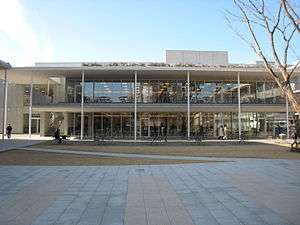 Southern Complex
Southern Complex
Shirokanedai Campus
The relatively small Shirokanedai Campus[36] hosts the Institute of Medical Science of the University of Tokyo (IMSUT), which is entirely dedicated to postgraduate studies. The campus is focused on genome research, including among its facilities the Human Genome Center (HGC), which have at its disposal the largest supercomputer in the field.[37]
Notable alumni and faculty members
- The university has produced many notable people. 15 prime ministers of Japan have studied at the University of Tokyo.[38] Former prime minister Kiichi Miyazawa ordered Japanese government agencies to reduce the rate of employees who had attended the university's law faculty to below 50 percent due to concerns about diversity in the bureaucracy.[39]
- Twelve alumni of University of Tokyo have received the Nobel Prize or the Fields Medal.
- Kunihiko Kodaira, Mathematics, 1954
- Sin-Itiro Tomonaga, Physics, 1965
- Yasunari Kawabata, Literature, 1968
- Leo Esaki, Physics, 1973
- Eisaku Satō, Peace, 1974
- Kenzaburō Ōe, Literature, 1994
- Masatoshi Koshiba, Physics, 2002
- Yoichiro Nambu, Physics, 2008
- Ei-ichi Negishi, Chemistry, 2010
- Satoshi Ōmura, Medicine, 2015
- Takaaki Kajita, Physics, 2015
- Yoshinori Ohsumi, Medicine, 2016
- Three have received the Pritzker Architecture Prize:
Part of Nobel prize laureates
 Yasunari Kawabata Literature, 1968
Yasunari Kawabata Literature, 1968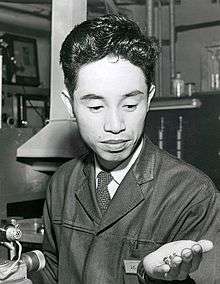 Leo Esaki, Physics, 1973
Leo Esaki, Physics, 1973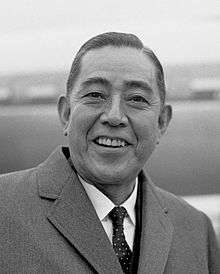 Eisaku Satō, Peace, 1974
Eisaku Satō, Peace, 1974 Kenzaburō Ōe, Literature, 1994
Kenzaburō Ōe, Literature, 1994 Yoichiro Nambu, Physics, 2008
Yoichiro Nambu, Physics, 2008 Ei-ichi Negishi, Chemistry, 2010
Ei-ichi Negishi, Chemistry, 2010
Scientists
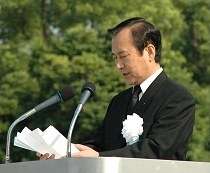




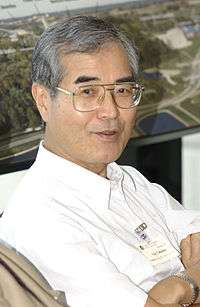

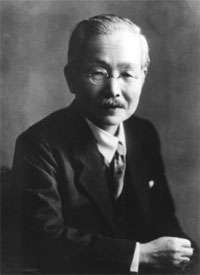
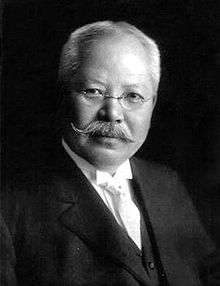
- Charles Dickinson West mechanical Engineer

See also
- Gakushi-kai Alumni association
- Imperial College of Engineering
- Earthquake engineering
- Kikuchi Dairoku
- Koishikawa Botanical Gardens
- Nikko Botanical Garden
- The University of Tokyo Library
- International Journal of Asian Studies published in association with the Institute for Advanced Studies on Asia, University of Tokyo
References
- ↑ "University of Tokyo [Organization] Number of Students / Personnel". Retrieved 2007-06-14.
- ↑ "東京大学 (学生数)学生・研究生・聴講生数". Retrieved 2007-06-14.
- ↑ "The Todai-Yale Initiative". Retrieved 12 June 2015.
- ↑ "UTokyo Mini Brochure" (PDF). Retrieved 18 April 2017.
- ↑ The School and the University. University of California Press. 1985. p. 156. ISBN 978-0-520-05423-3.
- ↑ Lincoln, Edward J. (2001). Arthritic Japan: the slow pace of economic reform. Brookings Institution Press. p. 148. ISBN 0-8157-0073-3.
- 1 2 LOST MEMORY - LIBRARIES AND ARCHIVES DESTROYED IN THE TWENTIETH CENTURY (Archived August 30, 2011, at WebCite)
- ↑ 漢籍関係年表. Chinese classics (in Japanese). Tokyo University General Library. Retrieved 5 September 2011.
- ↑ 東大と天皇-大日本帝国の生と死 (Todai and Emperors - Life and Death of Imperial Japan), by 立花 隆(Takashi Tachibana), (pp 22-62), ISBN 4-16-367440-3
- ↑ 1964 Summer Olympics official report. Volume 2. Part 2. p. 761.
- 1 2 Brasor, Philip, "Todai calls for change, but will others follow?", Japan Times, 5 February 2012, p. 9.
- ↑ Aoki, Mizuho, "Reform means the world for Todai", Japan Times, 18 February 2012, p. 3.
- ↑ "PEAK Programs"
- ↑ "The University of Tokyo, PEAK - Programs in English at Komaba - Introduction". Retrieved 12 June 2015.
- ↑ http://www.s.u-tokyo.ac.jp/GSC/index.html
- 1 2 3 "Departments". The University of Tokyo.
- ↑ Organizations with ties to CCEP CCEP, accessed 2011-03-19
- ↑ "Academic Ranking of World Universities 2017". Institute of Higher Education, Shanghai Jiao Tong University. 2017. Retrieved August 17, 2017.
- ↑ "World University Rankings 2016-2017". Times Higher Education. 2016. Retrieved October 22, 2016.
- ↑ "QS World University Rankings 2018". Quacquarelli Symonds Limited. 2017. Retrieved June 21, 2017.
- ↑ "Academic Ranking of World Universities". Institute of Higher Education, Shanghai Jiao Tong University. 2017. Retrieved August 17, 2017.
- ↑ "Asia University Rankings 2017". Times Higher Education. 2017. Retrieved 17 August 2017.
- ↑ "QS University Rankings: Asia 2016". Quacquarelli Symonds Limited. 2016. Retrieved July 11, 2016.
- ↑ "World University Rankings". The Times Higher Educational Supplement. 2013. Retrieved 2013-07-24.
- ↑ "Asia University Rankings Top 100". The Times Higher Educational Supplement. 2013. Retrieved 2013-07-24.
- ↑ "World University Rankings 2014-15". The Times Higher Education. Retrieved 9 September 2015.
- ↑ "QS World University Rankings". Topuniversities. Retrieved 2011-10-01.
- ↑ "QS World University Rankings". Topuniversities. Retrieved 2011-10-01.
- ↑ "QS World University Rank for Natural Sciences". Topuniversities. Retrieved 2017-03-23.
- ↑ "QS World University Rank for Engineering & Technology". Topuniversities. Retrieved 2017-03-23.
- ↑ "TOP - 100 (Global universities ranking)". Global Universities Ranking. 2009.
- ↑ "300 Best World Universities 2010". ChaseCareer Network.
- ↑ "International Professional Ranking of Higher Education Institutions". École nationale supérieure des mines de Paris. 2011.
- ↑ "Nature Publishing Index: Global Top 50". Nature Publishing Group. 2012.
- ↑ 第86期五月祭常任委員会. "トップページ|東京大学 第86回五月祭". 第86回五月祭公式ウェブページ. Retrieved 12 June 2015.
- ↑ http://www.ims.u-tokyo.ac.jp/imswww/About/map0310-e.html
- ↑ Human Genome Center, the Institute of Medical Science, the University of Tokyo. "Human Genome Center". Retrieved 12 June 2015.
- ↑ "大学別総理大臣リスト List of prime ministers by graduated universities" (in Japanese). 大学ranking.net.
- ↑ McGregor, Richard (15 May 2010). "China's Private Party". Wall Street Journal.
External links
| Wikimedia Commons has media related to University of Tokyo. |
- University of Tokyo
- Kato, Mariko, "Todai still beckons nation's best, brightest but goals diversifying", Japan Times, August 11, 2009, p. 3.
